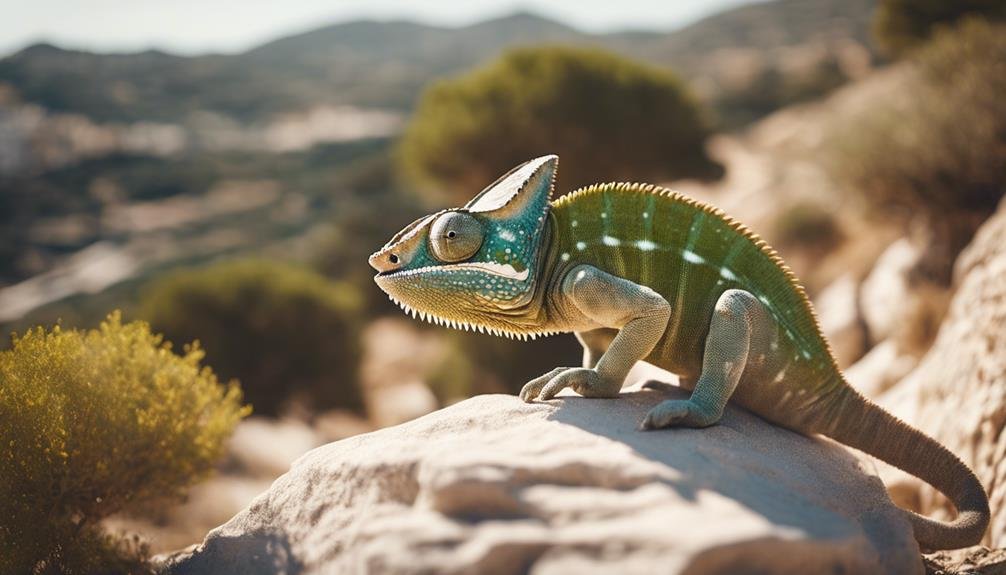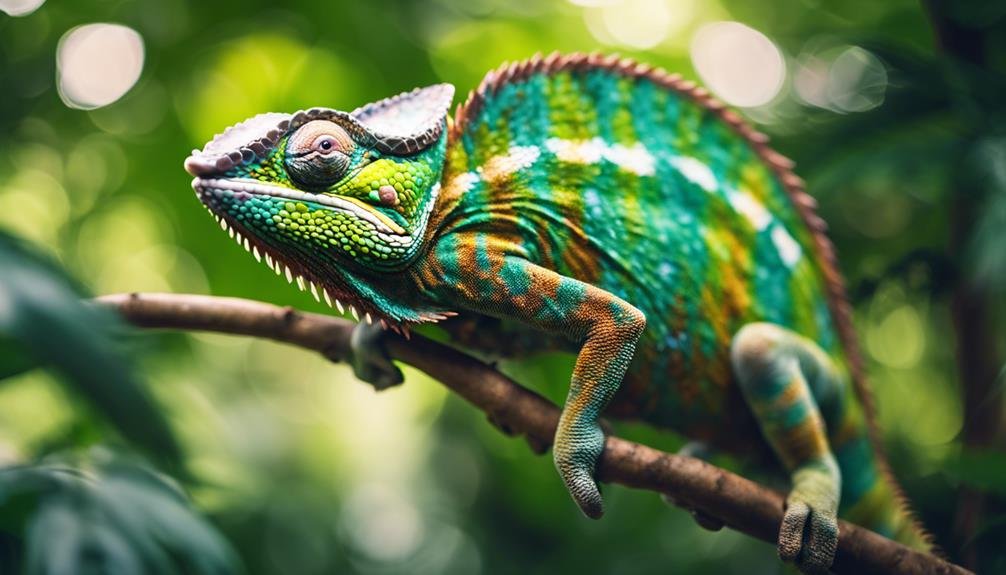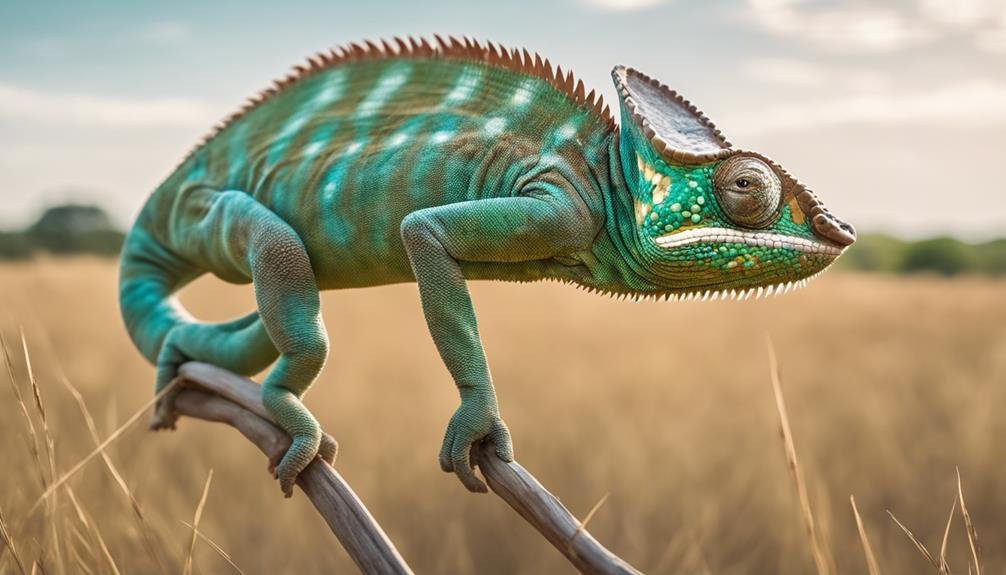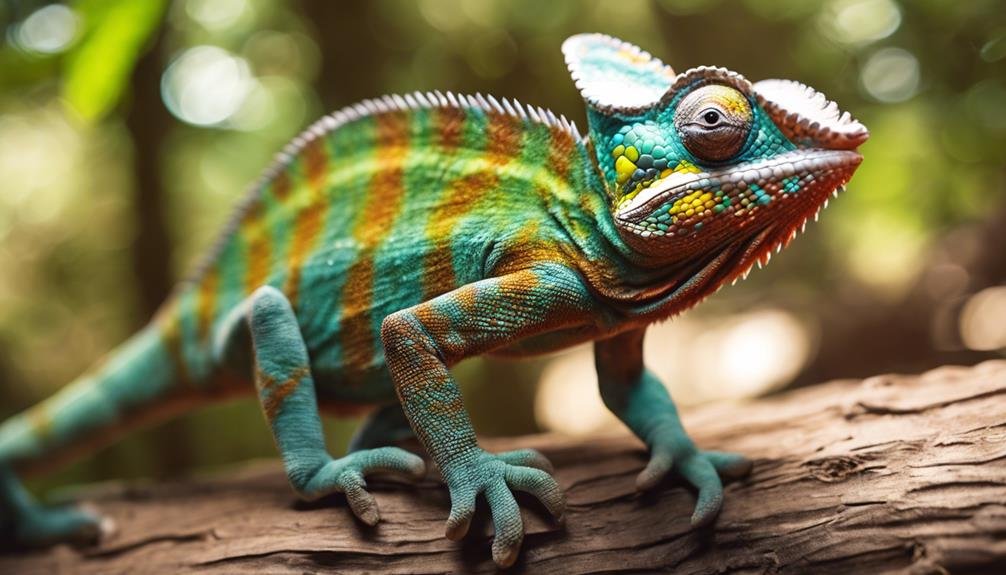As you explore the natural habitats and homes of chameleons, you’ll find these remarkable reptiles thriving in a variety of environments, from the arid deserts of Africa to the lush rainforests of Madagascar, and even in certain regions of Europe and Asia. Their ability to adapt is not just about their famous color-changing skin but also involves intricate behaviors and physiological adaptations suited to each unique habitat. Considering the vast diversity among chameleon species, you might wonder how these creatures have evolved to occupy such a wide range of ecological niches. Let’s uncover the secrets behind their survival and the challenges they face in their natural surroundings.
Key Takeaways
- Chameleons are native to Africa, Madagascar, southern Europe, and parts of Asia.
- They inhabit diverse environments including rainforests, deserts, savannas, and mountainous regions.
- In Africa, chameleons adapt to arid deserts, tropical forests, and cool highlands.
- Madagascar is home to over half of the world’s chameleon species, offering unique habitats.
- In captivity, creating environments that mimic their natural habitat is crucial for their health.
Chameleons’ African Origins
Chameleons trace their origins back to Africa, where about 160 species have been identified across the continent. This diverse group of reptiles showcases a wide range of shapes, sizes, and colors, reflecting the rich variety of habitats they occupy. You’ll find these fascinating creatures dwelling in everything from arid deserts in northern Africa to the lush, tropical forests in central regions. Each area hosts different species of chameleon, adapted to thrive in specific environmental conditions.
In northern Africa, chameleons have evolved to survive in harsh, desert climates, showcasing their remarkable adaptability. Meanwhile, central Africa is a hotspot for chameleon diversity, home to species like the Senegal and Graceful chameleons, which flourish in its dense forests and verdant landscapes. Moving southward, unique species such as Jackson’s and Meller’s chameleons inhabit the varied ecosystems of southern Africa, from cool highlands to warm coastal areas.
This vast array of habitats within Africa supports an incredible diversity of chameleon life, with each region offering a unique array of species. As you explore Africa’s landscapes, you’re uncovering the cradle of chameleon evolution, where these mesmerizing reptiles have developed an astonishing array of forms and behaviors to adapt to their surroundings.
Madagascar: Island of Diversity
Madagascar, a vital island of diversity, hosts over half of the world’s chameleon species. This incredible place isn’t just an island but a world of its own, brimming with unique chameleon species that you won’t find anywhere else on Earth. The chameleons of Madagascar, from the distinct genera of Calumma, Furcifer, and Brookesia, showcase the island’s unparalleled biodiversity and its significance as a habitat for these fascinating reptiles.
Imagine walking through the lush rainforests of Madagascar and encountering:
- Tiny Brookesia chameleons, barely visible among the leaf litter, challenging your perceptions of size and survival.
- The striking Furcifer chameleons, flaunting their vibrant colors that shimmer and change, captivating your senses.
- Calumma species, expertly camouflaged among the dense foliage, a tribute to the wonders of evolution.
- The awe-inspiring sight of chameleons blending into their environments so seamlessly, they seem like living, breathing parts of the forest itself.
Madagascar’s unique ecosystem supports these extraordinary chameleon species, making the island a critical sanctuary for their continued existence. As you marvel at the diversity and adaptability of these creatures, you’re reminded of the natural world’s fragility and the importance of preserving such irreplaceable habitats.
European Chameleon Habitats


In southern Spain and Portugal, you’ll find the exclusive habitats of Europe’s two chameleon species: the Common Chameleon and the African Chameleon. These unique creatures have adapted to live in specific areas, thriving in environments that meet their distinct needs. The natural habitat of these chameleons is fascinating, as it showcases their ability to survive and flourish in European climates, which differ considerably from those of their counterparts in Africa or Madagascar.
| Species | Location | Habitat Characteristics |
|---|---|---|
| Common Chameleon | Southern Spain | Dense vegetation, warm climate |
| African Chameleon | Portugal | Coastal areas, mild temperatures |
| Both Species | Iberian Peninsula | Limited distribution, unique ecosystems |
The table above highlights the distinct environments these chameleons call home. Despite facing environmental challenges due to their limited distribution, these chameleons have carved out a niche for themselves in the southern regions of Europe. Their adaptation to the specific climates and ecosystems of southern Spain and Portugal underlines the resilience and versatility of chameleons as a species. As you explore the natural habitat of European chameleons, you’re witnessing the remarkable adaptability of these creatures, ensuring their survival in a continent far removed from the tropical environments typically associated with their kind.
Asian Regions and Species
While exploring Asia, you’ll discover that the Indian chameleon, found in both India and Sri Lanka, represents the region’s contribution to chameleon diversity. This unique species showcases the rich biodiversity found across the Asian landscapes, particularly in the lush environments of Sri Lanka. While Asia may not boast the same variety of chameleons as Africa, the presence of the Indian chameleon in these areas highlights the adaptability and broad distribution of chameleons globally.
- The Indian chameleon’s adaptability: Witness how this species thrives in both dry and humid climates, embodying the resilience of nature.
- Sri Lanka’s rich biodiversity: Feel the awe as you explore the lush, green forests of Sri Lanka, a haven for diverse wildlife including the Indian chameleon.
- The presence of Jackson’s chameleons in Hawaii: While not native, their existence in distant lands like Hawaii underlines the unexpected connections between regions and the impact of human activity on wildlife distribution.
- Conservation concerns: The plight of these creatures, amidst shrinking habitats and changing climates, stirs a sense of urgency and responsibility towards preserving our planet’s incredible biodiversity.
Understanding the habitats and challenges faced by species like the Indian chameleon in Asia allows us to appreciate the intricate tapestry of life on Earth and emphasizes the importance of conservation efforts.
Rainforest Dwellers


Diving into the heart of African rainforests, you’ll find chameleons skillfully moving through their tree-bound homes, their vibrant green skin a perfect match for the lush surroundings. These chameleons are the epitome of adaptation, thriving in environments where dense vegetation, tall trees, and high moisture levels dominate. Their green skin doesn’t just serve as a hide-and-seek champion’s cloak; it’s a crucial part of their survival toolkit, allowing them to blend seamlessly with the foliage around them.
As tree-dwelling species, rainforest chameleons have mastered the art of traversing the vertical world. The tall trees of the African rainforests provide not just shelter but a hunting ground, where their color-changing abilities come into play. It’s not all about camouflage, though. Their ability to shift hues also helps them regulate their body temperature amid the humid rainforest climate, a clever trick for dealing with the heat.
Living in such a vibrant, life-filled habitat, these chameleons embody the spirit of the rainforest. Every move they make, every color they shift into, speaks to the intricate dance of adaptation and survival. In the heart of the rainforest, they’re truly at home, their green skin a proof of their belonging.
Desert Adaptations
Venturing beyond the lush, dense canopies of rainforests, you’ll find chameleons in the Sahara desert mastering the art of survival in stark contrast to their green cousins. These desert chameleons, like the Namaqua, are experts at living under the scorching sun. Their survival hinges on a fascinating blend of biological tricks, primarily their skin’s ability to undergo color changes, which is vital for regulating their body temperature amid the extreme heat.
Desert chameleons use color changes to masterfully absorb or reflect sunlight, an essential strategy for keeping cool or warming up. Their typically light coloration reflects heat, while darkening allows them to absorb warmth when the desert cools. Specialized skin cells enable these remarkable creatures to adjust their hues based on temperature and surrounding conditions, making them the ultimate survivors.
Inhabiting such harsh environments, desert chameleons showcase an incredible adaptation, turning the challenges of the Sahara into a tribute to their resilience.
Their ability to blend in with the sandy environments not only aids in temperature regulation but also in camouflage, proving that even in the most inhospitable places, life finds a way to thrive.
Savanna and Grassland Residents


Chameleons in savannas and grasslands have evolved unique adaptations to traverse their open, sparse habitats effectively. Among these adaptable reptiles, species like the flap-necked chameleons roam across Africa’s vast savannas. They’ve mastered life in environments where trees and bushes are scattered, not dense. Their specialized feet are a marvel, perfectly designed for climbing on grasses and low vegetation without a hitch.
As you explore these vast plains, you’ll notice how savanna chameleons become one with their surroundings. They change color to blend seamlessly with grasses and shrubs, a natural cloak of invisibility against predators. This color-changing prowess isn’t just for show; it’s crucial for their survival, allowing them to thrive in the open grassland environments that could otherwise leave them exposed.
Veiled chameleons, commonly kept as pets, share these remarkable adaptations, though they typically hail from slightly different habitats. Yet, the skills of their savanna and grassland cousins highlight the adaptability and resilience of chameleons as a group. Whether traversing the sparse cover of grasslands or the slightly more sheltered environments of other habitats, their unique adaptations ensure their survival.
Mountainous Areas and Elevation
As you move up to mountainous regions, chameleons showcase remarkable altitude adaptations. These areas are home to a diverse array of chameleon species, each uniquely suited to the challenges of life at high elevations.
Let’s explore how these reptiles thrive in environments ranging from cool, misty heights to the lush, vegetated zones that dot the mountainside.
Altitude Adaptations
Inhabitants of mountainous regions, some chameleons have evolved remarkable adaptations to survive altitudes between 1,600 and 2,440 meters. These mountainous species thrive in conditions that would challenge many, thanks to their altitude adaptations. They’ve become masters of their high-altitude homes, where life demands resilience.
- Chameleons in these areas navigate humid habitats with seasonal rainfall over 127 cm, ensuring lush, dense vegetation for shelter and hunting.
- They endure temperature swings from 16–27°C by day to a cooler 4–18°C at night, adjusting their activity accordingly.
- Residing in shrubs, low trees, and ground vegetation, they’ve adapted to a life less ordinary, blending seamlessly into their elevated world.
- These chameleons showcase the remarkable ability to adapt and thrive, embodying the spirit of survival against the odds.
Mountain Species Diversity
Building on their altitude adaptations, let’s explore the diverse species of chameleons making the mountainous regions their home. These mountain species thrive at altitudes between 1,600 and 2,440 meters, where they’ve masterfully adapted to the climate.
The conditions here are no small feat to conquer, with humidity high enough to touch the clouds and annual rainfall topping 127 cm. During the day, temperatures swing from a pleasant 16 to 27 °C, but at night, they can plummet to a chilly 4–18 °C.
It’s in these rugged terrains, among shrubs, low trees, and higher elevation vegetation, that these chameleons find their sanctuary. They’ve become experts at surviving in mountainous terrains, perfectly adapted to the unique challenges these habitats present.
Captive Care and Environments


Creating the ideal captive environment for chameleons demands an enclosure that closely mirrors their natural habitat, focusing on proper lighting, humidity, and temperature to maintain their health. You’ve got to understand their need to change color isn’t just for show; it’s a critical part of their wellbeing, which is why the right enclosures are so vital. They don’t just live in these spaces; they thrive when every detail is thoughtfully considered.
Here’s what you need to do to evoke emotion and make sure your chameleon not only survives but flourishes:
- Replicate their natural world with live plants, branches, and hiding spots to give them a sense of home.
- Maintain optimal humidity and temperature, mimicking their wild environment, to keep them comfortable and healthy.
- Provide a diet rich in calcium and vitamins, because just like us, what they eat greatly impacts their wellbeing.
- Monitor their health regularly, paying close attention to their skin color, shedding, and eating habits to catch any issues early.
Do Chameleons Change Color Based on Their Natural Habitats and Homes?
Chameleons change color to regulate their body temperature and communicate with other chameleons. However, their color-changing ability is not solely based on their natural habitats and homes. Rather, it is influenced by factors such as mood, temperature, and light. It’s fascinating to observe how chameleons change color.
Frequently Asked Questions
What Is a Chameleon’s Natural Habitat?
You’re curious about a chameleon’s natural habitat, right? Well, they’re not just hanging out in one place. These adaptable creatures make their homes in tropical rainforests, deserts, savannas, and even mountains.
They’re mostly up in the trees, thanks to their cool feet and long tongues, munching on insects and dodging predators. Their ability to change color? That’s perfect for blending in, whether they’re avoiding danger or sneaking up on their next meal.
What Do Chameleons Live in at Home?
At home, chameleons live in terrariums that mimic their natural habitats. You’ll need to set up a terrarium with plenty of climbing branches and foliage, ensuring they’ve got a space that feels like the wild.
Pay attention to their diet too; it should include a variety of insects like crickets and mealworms. Proper lighting and humidity are essential for their health.
This setup helps your chameleon thrive, just like they’d in nature.
What Is the Best Habitat for a Chameleon?
The best habitat for a chameleon mimics their wild environment, with plenty of live plants, branches, and hiding spots. You’ll need to guarantee proper lighting, humidity, and temperature control for their health. A spacious enclosure allows them to climb and move freely.
It’s crucial to keep them hydrated and offer a varied diet. Don’t fall for color-changing myths; their skin color indicates health. Watch their shedding and eating habits to gauge their well-being.
What Climate Zone Do Chameleons Live In?
You’re looking at chameleons’ climate zones, focusing on their climate adaptation and geographic distribution. These creatures thrive in climates ranging from tropical rainforests to deserts, savannas, and even mountainous areas.
They’ve adapted to live in environments with temperatures typically between 16–27°C during the day and cooler at night, from 4–18°C. Their ability to inhabit various climates shows their remarkable adaptability, living in diverse ecosystems around the world.
Conclusion
To sum up, you’ve discovered that chameleons are incredibly versatile creatures, thriving in environments as varied as Africa’s sprawling savannas, Madagascar’s unique ecosystems, Europe’s selective spots, and Asia’s lush landscapes. Whether adapting to rainforests, deserts, grasslands, or mountainous terrains, these remarkable reptiles showcase their resilience.
Even in captivity, replicating their natural homes is essential for their well-being. So, wherever you find them, chameleons are masters of adaptation, seamlessly blending into their surroundings and thriving.


